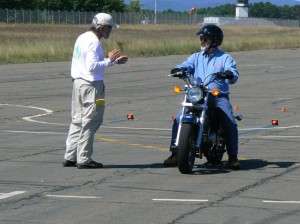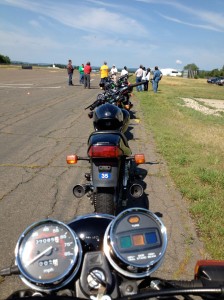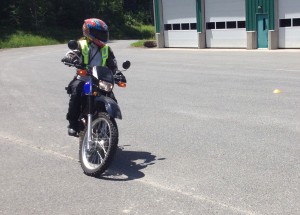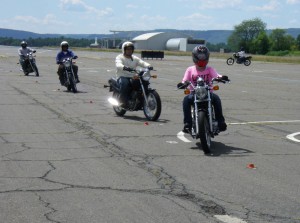
I recently wrote a blog post asking whether rider training is effective or not. In that post, I talk about the limits of basic rider training and discuss reasons why current training programs aren’t able to reduce fatalities.
In this post, I’ll talk about the problems with current MSF curriculum and how it can inadvertently give false confidence to new riders.
Case Study
This past weekend, I taught a Motorcycle Safety Foundation Basic RiderCourse (BRC). Within the group of 10, two students in particular were of concern. One person could barely achieve enough speed for stability, which is not unusual for the first few exercises, but this went on for the entire weekend. The other student of concern was an older man who struggled with basic coordination that hindered his ability to use the brakes and throttle and to shift without virtually pulverizing the transmission into dust. He also did not improve as expected.
None of this is terribly unusual early in the curriculum. After all, the course is designed for absolute newbies. As time goes on, most riders improve, but some do not. Unless a student is either posing a danger or is hindering the progress of the other students, the coaches are able to let them continue.
What is also not terribly unusual is for really weak riders to actually “pass” the course by wobbling through the final evaluation, performing just good enough to be within a minimum standard. In the case of these two students my fellow coach and I never imagined that either one would meet the standards of the evaluation, but they both did. What does that say about the course and the evaluation in particular?
Just the Beginning, No Really!
Overall, I think the MSF Basic RiderCourse does a good job at introducing people to motorcycling. The problem is that by issuing a completion card (that often leads to a motorcycle license endorsement), the students are at risk of thinking they have been given the blessing of certified instructors to go forth and ride like the wind. Hang on, there Bucco.
If you read the objectives of the MSF curriculum you’ll see a statement exclaiming that the Basic course is just the beginning and that it is important for students to practice on their own motorcycle after completion of the course. As long as Rider Coaches convey this information with conviction and the students actually listen to their Coaches, then perhaps the students will perceive their abilities as what they are: BASIC. Unless this concept is driven home, then the Basic Course will likely be the beginning and end of many riders’ training.
Next Steps
Telling new riders that they must practice in a parking lot is all fine and well. But, is it enough? The two students I encountered last weekend need more than seat time. They need professional help. Private lessons would do each of them a world of good. But, will they do it? And is it even available?
And what about the average rider who passes the course with a decent score? They need more than just a two day class to become proficient. Any exclamation to students that they must continue their education has no credibility unless there is actually an accessible and affordable “next step” in rider training.
The MSF offers the BRC 2 (the old Experienced Ridercourse) and the Advanced RiderCourse, as well as the Street RiderCourse. Unfortunately, many training sites don’t offer or promote these programs, because they aren’t popular and are often cancelled from the schedule due to lack of interest. Some private options are available, including the Riding in the Zone Personal training program for more experienced riders.
Even if training is available, when already-licensed riders are approached with the idea of taking an advanced riding course, reading a skills book or article, or attending a track school, many scoff and turn away. Why? It seems that there is a belief that once a person learns the fundamental control skills, then they are all set; thank you very much.
There are emotional reasons as well. Many adults dislike being in the role of student, because they risk feeling incompetent, which is a real possibility when learning new and potentially difficult skills.
Evaluation Standards
Emphasizing that the BRC is a baby step toward proficiency and providing enticing opportunities for continuing education is important, but there are other problems, especially the fact that the evaluation standards are too easy and not realistic. An easy evaluation is popular with students who want to pass the course, as well as dealerships and manufacturers who want new customers, and even instructors who dislike having to fail students. But, a too-easy evaluation does a serious disservice to all involved.
The fact is that many, if not most graduates of the Basic course are not yet ready to ride on the road. Sure, they have learned basic operations, but not to any level of proficiency that can be considered sufficient for managing a “real life-sized” motorcycle among distracted drivers.
In many other professional training environments, the trainer has the final word on whether a student meets standards for not, even if they “pass” a test. Many motorcycle safety courses are also used for meeting the state licensing requirements, so standardized testing is the most practical way to go. It would be risky to allow instructors with below average judgment to have the power to fail one person and not another based on subjective criteria.
Unfortunately, without this ability to overrule the evaluation score sheet, weak riders who manage to somehow meet standard will continue to receive completion cards. Because of this, most coaches I know routinely have a heart to heart talk with riders who fall under this category after the evaluation is complete.
I’ve done it many times before. In extreme cases, I may say something like: “You met standard and passed the course, Chuck. BUT, if it were up to me you would not be receiving this completion card. In my professional opinion, you have a long way to go before you should consider riding on the street. If you decide to continue as a motorcycle rider, promise me you that you will buy a small used bike and practice, practice, practice in a parking lot and please consider coming back for private lessons and the BRC2 when you have a few miles under your belt.” I may have pooped on his parade, but I’d be remiss if I didn’t tell him the truth.
Force Change?
So, what’s the answer? In the UK and Europe mandatory rider training is a multi-level process that takes many months and a rather high price tag to receive a full license. But, it would be nearly impossible at this time to pass a regulation that would force new riders into a multistage training process before they can obtain their full “I’ll take that new ‘Busa” license.
So in the meantime I’ll continue to tell it like it is…because not everyone is cut out to ride a motorcycle.
How about this license test used in Japan? How do you think you’d do?
Please Donate to Keep the Articles Coming
If you liked this article and the many other articles on this site, please toss a buck or five into the hat. It’s greatly appreciated!
- Click the PayPal “Pay Now” button.
- Then indicate quantity in $2.00 increments. – Example: put “2” in “QUANTITY” field to donate $4.00, “3” for a $6.00 donation, etc.
Why $2.00? Due to the PayPal fee structure, a $2.00 donation is significantly more beneficial compared to a $1.00 donation.
Thank You!
Check out these related posts:
- “Riding in the Zone” Personal Training
- Is Rider Training Effective?
- How to Develop a Traction Sense
- #1 Reason for Motorcycle Crashes in Corners
Stay Informed: Subscribe NOW!
 Be a Better Rider: Sign Up for Personal Training with Ken
Be a Better Rider: Sign Up for Personal Training with Ken
Support Riding in the Zone: Buy a book
Support Riding in the Zone: Buy products from Twisted Throttle & Amazon








